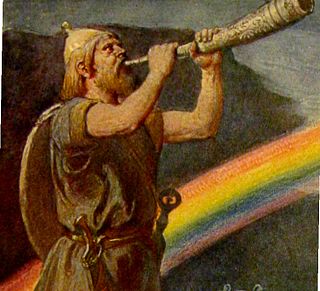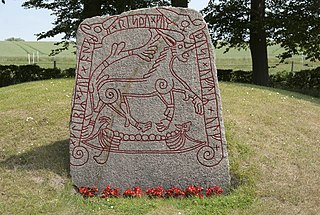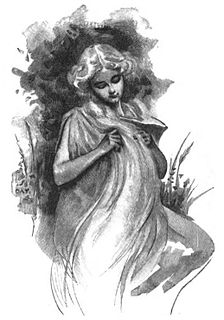Related Research Articles
Ægir, Hlér, or Gymir, is a jötunn and a personification of the sea in Norse mythology. In the Old Norse record, Ægir hosts the gods in his halls and is associated with brewing ale. Ægir is attested as married to a goddess, Rán, who also personifies the sea, and together the two produced daughters who personify waves, the Nine Daughters of Ægir and Rán, and Ægir's son is Snær, personified snow. Ægir may also be the father of the beautiful jötunn Gerðr, wife of the god Freyr, or these may be two separate figures who share the same name.

In Norse mythology, Bifröst or Bilröst is a burning rainbow bridge that reaches between Midgard (Earth) and Asgard, the realm of the gods. The bridge is attested as Bilröst in the Poetic Edda; compiled in the 13th century from earlier traditional sources, and as Bifröst in the Prose Edda; written in the 13th century by Snorri Sturluson, and in the poetry of skalds. Both the Poetic Edda and the Prose Edda alternately refer to the bridge as Ásbrú.

Fenrir or Fenrisúlfr, also referred to as Hróðvitnir and Vánagandr, or Vanargand, is a wolf in Norse mythology. Fenrir, together with Hel and the World Serpent, is a child of Loki and giantess Angrboða. He is attested in the Poetic Edda, compiled in the 13th century from earlier traditional sources, and the Prose Edda and Heimskringla, written in the 13th century by Snorri Sturluson. In both the Poetic Edda and Prose Edda, Fenrir is the father of the wolves Sköll and Hati Hróðvitnisson, is a son of Loki and is foretold to kill the god Odin during the events of Ragnarök, but will in turn be killed by Odin's son Víðarr.
In Norse mythology, Hvergelmir is a major spring. Hvergelmir is attested in the Poetic Edda, compiled in the 13th century from earlier traditional sources, and the Prose Edda, written in the 13th century by Snorri Sturluson. In the Poetic Edda, Hvergelmir is mentioned in a single stanza, which details that it is the location where liquid from the antlers of the stag Eikþyrnir flow, and that the spring, "whence all waters rise", is the source of numerous rivers. The Prose Edda repeats this information and adds that the spring is located in Niflheim, that it is one of the three major springs at the primary roots of the cosmic tree Yggdrasil, and that within the spring are a vast amount of snakes and the dragon Níðhöggr.

In Norse mythology, Rán is a goddess and a personification of the sea. Rán and her husband Ægir, a jötunn who also personifies the sea, have nine daughters, who personify waves. The goddess is frequently associated with a net, which she uses to capture sea-goers. According to the prose introduction to a poem in the Poetic Edda and in Völsunga saga, Rán once loaned her net to the god Loki.

Sigyn is a deity from Norse mythology. She is attested in the Poetic Edda, compiled in the 13th century from earlier traditional sources, and the Prose Edda, written in the 13th century by Snorri Sturluson. In the Poetic Edda, little information is provided about Sigyn other than her role in assisting her husband Loki during his captivity. In the Prose Edda, her role in helping Loki through his time spent in bondage is reiterated, she appears in various kennings, and her status as a goddess is mentioned twice. Sigyn may appear on the Gosforth Cross and has been the subject of an amount of theory and cultural references.

In Norse mythology, Valhalla is a majestic, enormous hall located in Asgard, ruled over by the god Odin. Half of those who die in combat travel to Valhalla upon death, led by valkyries to be with Odin, while the other half gets chosen by the goddess Freyja for the field Fólkvangr. In Valhalla, the dead warriors join the masses of those killed in combat and various legendary Germanic heroes and kings, as they prepare to aid Odin during the events of Ragnarök. Before the hall stands the golden tree Glasir, and the hall's ceiling is thatched with golden shields. Various creatures live around Valhalla, such as the stag Eikþyrnir and the goat Heiðrún, described as standing atop Valhalla and consuming the foliage of the tree Læraðr.

Fulla or Volla is a goddess in Germanic mythology. In Norse mythology, Fulla is described as wearing a golden band and as tending to the ashen box and the footwear owned by the goddess Frigg, and, in addition, Frigg confides in Fulla her secrets. Fulla is attested in the Poetic Edda, compiled in the 13th century from earlier traditional sources; the Prose Edda, written in the 13th century by Snorri Sturluson; and in skaldic poetry. Volla (Folla) is attested in the "Horse Cure" Merseburg Incantation, recorded anonymously in the 10th century in Old High German, in which she assists in healing the wounded foal of Phol and is referred to as Frigg's sister. Scholars have proposed theories about the implications of the goddess.

In Norse mythology, Sif is a golden-haired goddess associated with earth. Sif is attested in the Poetic Edda, compiled in the 13th century from earlier traditional sources, and the Prose Edda, written in the 13th century by Snorri Sturluson, and in the poetry of skalds. In both the Poetic Edda and the Prose Edda, she is known for her golden hair and is married to the thunder god Thor.

In Norse mythology, a valkyrie is one of a host of female figures who choose those who may die in battle and those who may live. Selecting among half of those who die in battle go to Fólkvangr, Freyjas afterlife, the other half go to the god Odin's hall called Valhalla. There, the deceased warriors become einherjar. When the einherjar are not preparing for the events of Ragnarök, the valkyries bear them mead. Valkyries also appear as lovers of heroes and other mortals, where they are sometimes described as the daughters of royalty, sometimes accompanied by ravens and sometimes connected to swans or horses.
In Norse mythology, Vár or Vór is a goddess associated with oaths and agreements. Vár is attested in the Poetic Edda, compiled in the 13th century from earlier traditional sources; the Prose Edda, written in the 13th century by Snorri Sturluson; and kennings found in skaldic poetry and a runic inscription. Scholars have proposed theories about the implications of the goddess.
In Norse religion, Sæhrímnir is the creature killed and eaten every night by the Æsir and einherjar. The cook of the gods, Andhrímnir, is responsible for the slaughter of Sæhrímnir and its preparation in the cauldron Eldhrímnir. After Sæhrímnir is eaten, the beast is brought back to life again to provide sustenance for the following day. Sæhrímnir is attested in the Poetic Edda, compiled in the 13th century from earlier traditional material, and the Prose Edda, written in the 13th century by Snorri Sturluson.

In Norse mythology, the Nine Mothers of Heimdallr are nine sisters who gave birth to the god Heimdallr. The Nine Mothers of Heimdallr are attested in the Prose Edda, written in the 13th century by Snorri Sturluson; in the poetry of skalds; and possibly also in a poem in the Poetic Edda, a book of poetry compiled in the 13th century from earlier traditional material. Scholars have debated what being "born of nine mothers" implies and have sought to connect the notion to other European folk motifs. Scholars have theorized that Heimdallr's Nine Mothers may be identical to the Nine Daughters of Ægir and Rán, who personify waves. In turn, Heimdallr would be born of the sea.

In Norse mythology, the einherjar literally "army of one", "those who fight alone") are those who have died in battle and are brought to Valhalla by valkyries. In Valhalla, the einherjar eat their fill of the nightly-resurrecting beast Sæhrímnir, and valkyries bring them mead. The einherjar prepare daily for the events of Ragnarök, when they will advance for an immense battle at the field of Vígríðr.

Urðarbrunnr is a well in Norse mythology. Urðarbrunnr is attested in the Poetic Edda, compiled in the 13th century from earlier traditional sources, and the Prose Edda, written in the 13th century by Snorri Sturluson. In both sources, the well lies beneath the world tree Yggdrasil, and is associated with a trio of norns. In the Prose Edda, Urðarbrunnr is cited as one of three wells existing beneath three roots of Yggdrasil that reach into three distant, different lands; the other two wells being Hvergelmir, located beneath a root in Niflheim, and Mímisbrunnr, located beneath a root near the home of the frost jötnar. Scholarly theory and speculation surrounds the well.

Sól or Sunna is the Sun personified in Germanic mythology. One of the two Old High German Merseburg Incantations, written in the 9th or 10th century CE, attests that Sunna is the sister of Sinthgunt. In Norse mythology, Sól is attested in the Poetic Edda, compiled in the 13th century from earlier traditional sources, and the Prose Edda, written in the 13th century by Snorri Sturluson.

In Norse mythology, the goddess Rán and the jötunn Ægir both personify the sea, and together they have nine daughters who personify waves. Each daughter's name reflects poetic terms for waves. The sisters are attested in the Poetic Edda, compiled in the 13th century from earlier traditional sources; the Prose Edda, composed in the 13th century; and in the poetry of skalds. Scholars have theorized that these daughters may be the same figures as the nine mothers of the god Heimdallr.

Hnoss is one of the daughters of Freyja and Óðr in Norse mythology.

In Norse mythology, Sága is a goddess associated with the location Sökkvabekkr. At Sökkvabekkr, Sága and the god Odin merrily drink as cool waves flow. Both Sága and Sökkvabekkr are attested in the Poetic Edda, compiled in the 13th century from earlier traditional sources, and in the Prose Edda, written in the 13th century by Snorri Sturluson. Scholars have proposed theories about the implications of the goddess and her associated location, including that the location may be connected to the goddess Frigg's fen residence Fensalir and that Sága may be another name for Frigg.

In Norse mythology, Sumarr and Vetr are personified seasons. Sumarr and Vetr, personified, are attested in the Poetic Edda, compiled in the 13th century from earlier traditional sources, and the Prose Edda, written in the 13th century by Snorri Sturluson. In both, the two are given genealogies, while in the Prose Edda the two figure into a number of kennings used by various skalds.
References
- Faulkes, Anthony (Trans.) (1995). Edda. Everyman. ISBN 0-460-87616-3
- Orchard, Andy (1997). Dictionary of Norse Myth and Legend. Cassell. ISBN 0-304-34520-2
- Orchard, Andy (Trans.) (2011). The Elder Edda. Penguin Classics. ISBN 978-0-14-043585-6
